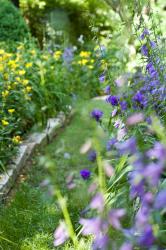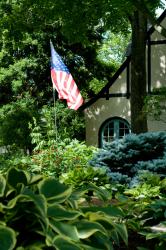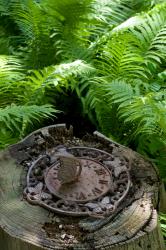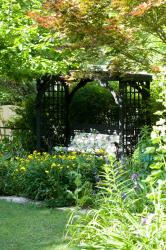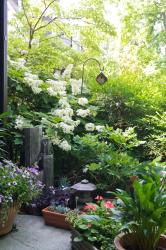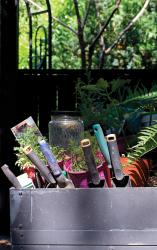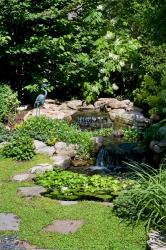If you would ask gardening aficionados in the St. Louis area to name their favorite spots, chances are many would list this Webster Groves garden. Filling both front and back yards, the lush, peaceful space, filled with hostas, ferns, specimen plants and walkways, seems to beckon visitors to take a stroll and be refreshed.
It is a garden that truly reflects the warm personalities and generosity of the two women who have created it and are more than happy to share their design with everyone from top garden experts to the occasional passersby. Featured on such prestigious garden tours as those sponsored by the Missouri Botanical Garden and the Nature Conservancy, Pat and Jean also regularly open the garden for Webster Groves High School fund raisers and local garden clubs. Neighbors out walking are invited to detour through the garden. “We maintain it for ourselves,” explains Jean, “but it’s also fun to share with other people.”
The story of the garden began in 1976 when Pat purchased the Tudor-style stucco home complete with a deep narrow yard she termed a “euonymous paradise.” There was “euonymous ground cover, a large euonymous bush and a euonymous vine arching over the French doors.” Pat knew she wanted a garden. She had loved gardening and flowers since she was 9 or 10 years old and her great-grandmother, who lived in South St. Louis, would walk her around to the front of the house to admire the four o’clocks. “I saw all those colors and fell in love,” Pat recalls. Work to clear the property began slowly. In addition to the euonymous, weedy, scrub maple and mulberry trees abounded and needed to be eliminated. In those days, tending to just a small part of the yard was as much as she could manage.
Fast forward to Pat’s retirement from Southwestern Bell in 1990. By then she had been joined by Jean Hudson, who also worked at Southwestern Bell. Jean’s love of the earth and gardening came directly from the farm near Nashville, TN, where she grew up. In the words of both women, it was in the 1990s that “the gardening got serious.”
Pat had joined the Webster Groves Women’s Gardening Association. While setting up for the group’s annual plant sale, fellow member Joan Hummel introduced Pat to the joys of hosta. In 1993 Pat and Jean combined a visit with Jean’s sister in Atlanta with a trip to the American Hosta Society Convention, also in Atlanta, and were truly hooked. “We went to the national convention before we went to the local convention,” Pat says laughing. The charm of hosta, she adds, comes from the “beauty, variety, color, shape and size of the foliage. They are beautiful plants all season long; they are peaceful plants. They go well with ferns, which we love.”
Hosta also allows their garden to be “triple planted,” Jean explains. The show begins in early spring with small bulbs and moves on to daffodils and tulips in later spring. Then, the hostas and ferns emerge to cover the bulb foliage. Bulb foliage, Pat notes, is “encouraged down,” rather than being tied down or cut off, to guarantee blooms in coming seasons. Recently, because they have run out of room in the garden, Pat and Jean have begun growing hostas in containers and have had spectacular results both in displaying more unusual species in the summer and over-wintering them in the same containers in the cold.
Over the years, Pat and Jean have absorbed knowledge by talking with other gardeners, reading magazines and by trial and error. They are, in Jean’s words, “always challenging the zones” and trying plants that may or may not do well in either the cold or heat in St. Louis. Each day in the garden, she notes, is “a moment in time.” Gardens are continually changing and never look exactly the same way twice. While they love to garden, they also are continually looking for ways to make their chores less labor intensive, Pat notes.
Here are some of their best tips:
* Pea gravel dug into the soil can work wonders. It discourages “chewing critters” who don’t like the sharp edges and loosens soil to allow plant roots to sink deeper and weeds to pull out more easily. It also allows water to perk down deeper, especially on slopes.
* Hostas can be cut down in mid to late fall to allow compost to be spread over garden beds. Mulching with compost cuts down on the need for fertilizer.
* Allowing flats of plants to soak for a short time in a solution of Epsom salts and liquid plant food before going into the ground eliminates transplant shock and gets small plants off to a good start.
* Dead-heading flowering plants regularly keeps gardens tidy and vigorous plants from actively re-seeding.
* Strips of old panty hose make great plant ties. They are elastic, an unobtrusive color and don’t rot.
* Use strips of old brown carpet, placed carpet-side down and covered with mulch, to create weed-free walkways.
* Large shrubs such as viburnum, crepe myrtle and button bush can be limbed up into small trees to provide an understory and shade for plants beneath.
* To eliminate weeding drudgery, seek out a hoe-length garden tool with a triangular head that easily flips weeds out of the ground.
Jean and Pat’s warmth and generosity encompasses everything they do. Just as their gardening got serious, they also opened their arms and home to Jean’s grand nieces, then ages 2 and 5, so the sisters, in need of a stable environment, could be raised together. Jamie, 21, is now a junior in college and Marissa, 18, will be beginning a pre-med program in the fall. While both women had been divorced and never envisioned children in their lives, raising the two girls has been a joy, they both agree. And they are hoping that their love of gardening will eventually be passed on to a new generation.


